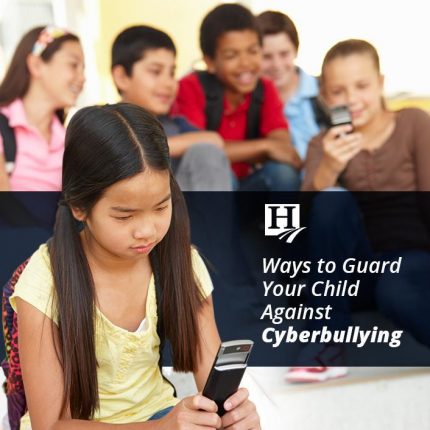Cyberbullying is on the rise! In part one of our series on cyberbullying, we discussed exactly what cyberbullying is and how to identify it. While that information is surely helpful, you also need to know just how to guard against it. Is there anything you can do to prevent it from happening in the first place?
Communicate Openly:
This is probably the biggest and best way you can protect your child. Did you know that 90% of cyberbullying victims don’t report it to a parent? You don’t want to be a part of that statistic. Instead, set aside some time to purposely discuss cyberbullying with your child. Let him or her know that you know what it is, it’s wrong and unacceptable, and if he or she is ever a victim, you’ll handle it. In addition, let your child know that you’re not going to judge him or her over anything that may have been posted (pics, posts, etc) on his or her behalf.
Be Involved:
You probably already stay on top of where your child is after school, who his or her friends are, where he goes for fun, etc. While that’s definitely something you should do, it’s nowhere near “enough.” In this day and age, social media has made it incredibly easy to bullies to attack. So, make sure you’re connected to your child’s social media by “following” his or her social accounts. Know his or her password and watch the things posted on social media. Keep in mind, though, that your child CAN prevent you from seeing what was posted by adjusting the privacy settings. Therefore, make sure YOU are able to see everything and that your child didn’t put you on “restricted” mode or “mute” you.
Use Security Settings:
The last thing you want is for your child to practically give cyberbullies the ammo they need. Instead, see to it that your child is very careful about just who gets to have access to what he or she shares online. On most social media apps, the default settings for things you post/share are set up so everything posted goes out to the public. Make sure your child has changed this on all apps so only friends or specific people you’ve approved are the people who see what he or she posts.
Restrict Basic Information:
When you sign up for social media apps, one of the first things they’ll ask is for you to enter your name, address, phone number, birthday, etc. On some apps, this information is viewable by any registered user. You have a couple options here: don’t provide your child’s real information (especially if it’s viewable by anyone who makes an account) or restrict access to that information. To restrict access, you may have to go to the app’s “privacy” or “security” settings.
Choose Online Friends Wisely:
Don’t allow your child to be online “friends” with people he or she doesn’t know in real life. Furthermore, he or she should only accept “friend requests” from people he or she knows and is friends with offline. (On Instagram and Twitter, the default settings allow anyone to “follow” anyone. You’ll have to change the settings so people have to request–and be approved–to follow your child.) If your child is online friends with someone who is now behaving in an unkind way or who is bullying your child in real life, let your child know it’s perfectly fine to “unfriend” or even “block” the person.
With cyberbullying at its peak, children are very susceptible to being bullied online and you may never even know about it. The best thing you can do is to be proactive about it by staying involved, communicating with your child, and monitoring your child’s online activity. In this way, you can guarantee your child doesn’t become another statistic.
Tasha Swearingen
Tasha is a homeschooling mom to 5 and has been homeschooling for 14 years. Currently, her children's ages span from toddler to young adult. Tasha has a Bachelor's of Science degree in Social Sciences from Florida State University and is working on her MBA through SNHU/Berklee School of Music.
Latest Posts

While nearly every college and university today is eager to accept homeschooled students into their institutions, homeschooling families need to understand that their student’s application…
Read more >
Guest Post by Gabriel Morse For several years, I sat for long hours every day behind one of those battleship gray desks in a windowless, dull, gray office. The pay was enough to take care…
Read more >
This post is sponsored by Little Monsters Universe. I'm Tina Salmanowitz, an advocate for homeschooling and science education. With over a decade of experience as a science educator (in class…
Read more >


